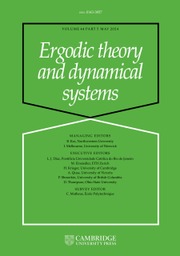The structure of basins of attraction and their trapping regions
Published online by Cambridge University Press: 17 April 2001
Abstract
In dynamical systems examples are common in which two or moreattractors coexist, and in such cases, the basin boundary isnonempty. When there are three basins of attraction, is itpossible that every boundary point of one basin is on the boundaryof the two remaining basins? Is it possible that all threeboundaries of these basins coincide? When this last situationoccurs the boundaries have a complicated structure. Thisphenomenon does occur naturally in simple dynamical systems.The purpose of this paper is to describe the structure andproperties of basins and their boundaries for two-dimensionaldiffeomorphisms. We introduce the basic notion of a ‘basin cell’. Abasin cell is a trapping region generated by some well chosenperiodic orbit and determines the structure of the correspondingbasin. This new notion will play a fundamental role in our mainresults. We consider diffeomorphisms of a two-dimensionalsmooth manifold $M$ without boundary, which has at least threebasins. A point $x\in M$ is a Wada point if every openneighborhood of $x$ has a nonempty intersection with at leastthree different basins. We call a basin $B$ a Wada basin ifevery $x\in\partial\bar{B}$ is a Wada point. Assuming $B$ is thebasin of a basin cell (generated by a periodic orbit $P$), we showthat $B$ is a Wada basin if the unstable manifold of $P$intersects at least three basins. This result implies conditionsfor basins $B_{1},B_{2},\ldots,B_{N}(N\ge 3)$ to satisfy$\partial\bar{B}_{1}=\partial\bar{B}_{2}=\cdots=\partial\bar{B}_{N}$.
Information
- Type
- Research Article
- Information
- Copyright
- 1997 Cambridge University Press
Footnotes
- 16
- Cited by

